Holistic SEO
Video SEO: Maximizing YouTube’s Search Potential
Harness the power of Video SEO to elevate your YouTube channel’s visibility—discover essential strategies that could transform your content’s reach.

To maximize YouTube's search potential, focus on optimizing your video metadata like titles, descriptions, and tags with relevant keywords. Create engaging thumbnails to boost click-through rates and hold viewer attention with compelling content. Aim for videos around 11 minutes long to enhance watch time, which signals value to YouTube. Keep an eye on your performance metrics—engagement metrics like likes and comments play a big role in rankings. By understanding your audience and fine-tuning your strategies, you can greatly improve your video's visibility. There are plenty more tips and tricks that can help you succeed.
Key Takeaways
- Optimize video metadata with relevant keywords in titles, descriptions, and tags to enhance discoverability and visibility on YouTube.
- Create engaging thumbnails and titles to improve click-through rates and attract viewers to your content.
- Focus on audience retention by crafting compelling content that keeps viewers engaged for over 50% of the video duration.
- Analyze performance metrics like watch time, CTR, and engagement rates regularly to refine your content strategy and improve rankings.
- Utilize tools like VidIQ and Canva for effective keyword research and visually appealing thumbnails to boost your video SEO efforts.
YouTube SEO Basics
How can you make your videos stand out on YouTube? The answer lies in mastering YouTube SEO. Start by focusing on video metadata—titles, descriptions, and tags. These elements should contain relevant keywords that enhance your search placements and catch viewers' attention.
This isn't just about getting clicks; it's also about audience engagement. Encouraging likes, shares, and comments, as well as implementing a methodical approach to your content creation, greatly influences your video rankings.
When it comes to video length, aim for around 11 minutes. Longer videos often rank better because they keep viewers engaged for more extended periods, boosting your watch time. Plus, higher watch time signals to YouTube that your content is valuable, which can lead to subscriber growth.
Regularly analyze your performance metrics to refine your strategies. Understanding how viewers interact with your content will help you optimize your content for better results.
Key Ranking Factors

When it comes to ranking your videos, user engagement metrics play an essential role.
Effective email marketing strategies can also apply to video content, as understanding your audience's preferences can lead to better engagement.
You'll want to focus on optimizing your video metadata, including titles and descriptions, to attract viewers and keep them watching.
Engagement Metrics Importance
Engagement metrics play an essential role in determining your video's success on platforms like YouTube. These metrics, which include likes, comments, and shares, signal to the YouTube algorithm that your content resonates with viewers. When your videos encourage viewer interaction, they gain traction, leading to improved search rankings.
Additionally, fostering a creative environment at home can inspire unique content ideas that captivate your audience and enhance engagement metrics, as seen in family activities that promote creativity.
One important aspect is the click-through rate (CTR); compelling thumbnails and titles can greatly enhance your CTR, driving more viewers to your content.
Furthermore, audience retention rates are key; videos that keep viewers engaged for longer periods tend to rank better. The algorithm favors content that maintains viewer interest throughout its duration, boosting your video's visibility.
Incorporating calls-to-action (CTAs) within your videos can further encourage viewer interaction. When you prompt viewers to like, comment, or share your video, you increase those essential engagement metrics, leading to higher rankings on YouTube.
Ultimately, the more you focus on creating engaging content that captivates your audience, the more likely you're to improve your search rankings. Remember, prioritizing engagement metrics is fundamental for maximizing your YouTube's search potential and overall success.
Optimizing Video Metadata
Optimizing your video's metadata is essential for enhancing its visibility on platforms like YouTube and Google. To achieve this, focus on using relevant keywords in your video titles and descriptions. Engaging titles that are clear and concise can greatly boost your click-through rates. Aim for titles that not only grab attention but also integrate your target keywords naturally, avoiding keyword stuffing penalties.
Additionally, consider exploring best websites to earn money online to gain insights into how others optimize content for monetization.
In your video description, front-load key information and relevant keywords, as this helps search algorithms recognize your content's focus. Incorporate links and calls to action to guide viewer engagement effectively. Additionally, using 5-8 relevant hashtags in your video description can categorize your content and increase discoverability. Hashtags allow YouTube to better understand your video's context and relevance, improving its chances of appearing in video search results.
Don't forget that regularly updating your video metadata, including titles and descriptions, can improve your search rankings over time. By reflecting changes in content focus and audience interests, you'll keep your videos optimized for the best performance.
Utilize keyword research tools to stay on top of trends and make sure your metadata remains impactful.
Effective Keyword Research

Since effective keyword research is essential for boosting your video's visibility, understanding how to identify the right terms can make a significant difference. Start by focusing on relevant keywords that your target audience is searching for. Tools like Google Trends and VidIQ can help you discover trending topics and their search volume.
Long-tail keywords are particularly effective for video SEO, as they tend to be less competitive and more specific. By incorporating these keywords into your video titles and descriptions, you can enhance your discoverability on YouTube's search algorithms.
Here's a quick reference table to guide your keyword research:
| Keyword Type | Description | Example |
|---|---|---|
| Primary Keywords | Core terms related to your content | "Cooking Tutorials" |
| Long-Tail Keywords | Specific phrases with low competition | "Easy Vegan Recipes" |
| Competitor Keywords | Terms used by successful videos | "Quick Dinner Ideas" |
Remember to place the primary keyword in the first few sentences of your video descriptions. This strategy amplifies your content's potential to rank higher and reach more viewers.
Engaging Video Thumbnails
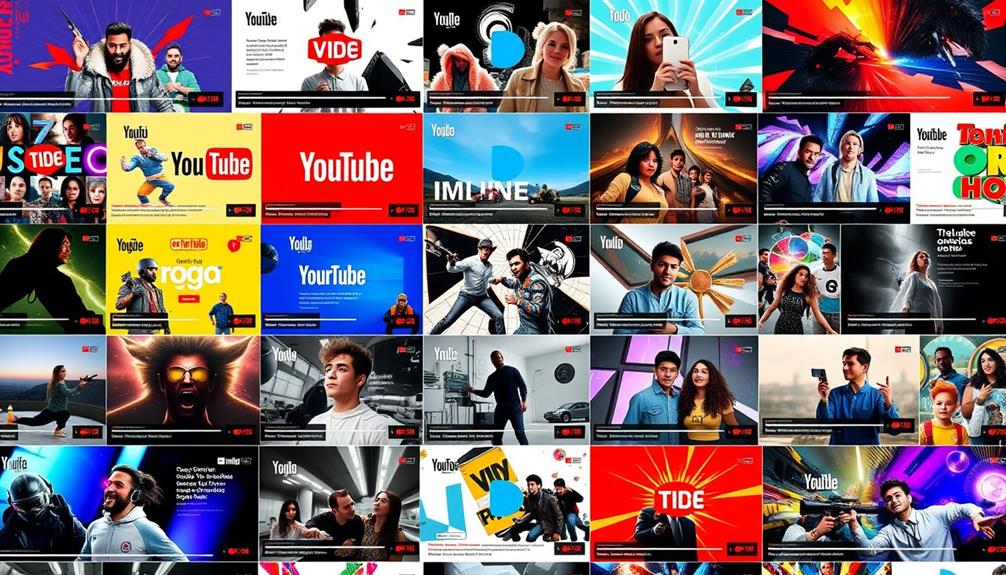
A fascinating video thumbnail can make all the difference in attracting viewers to your content. Engaging video thumbnails serve as the first impression, and using a custom thumbnail can increase your click-through rates by up to 30%.
To capture viewer attention effectively, guarantee your thumbnails are 1280×720 pixels, providing clarity on any device. Incorporating AI-generated music tools can also inspire creative approaches to video content that resonate with your audience.
Incorporating bold text and vibrant colors enhances visual appeal, allowing your video thumbnails to stand out in crowded search results and suggested videos. This is essential for driving viewer engagement, as a well-designed thumbnail can entice clicks and views.
Consistent branding across your thumbnails helps establish a recognizable identity for your channel. When viewers see your branding, they're more likely to trust your content, fostering loyalty and repeat views.
Regularly testing different thumbnail designs can also reveal what resonates best with your audience, allowing you to optimize your video content for higher engagement and visibility.
Audience Targeting Strategies
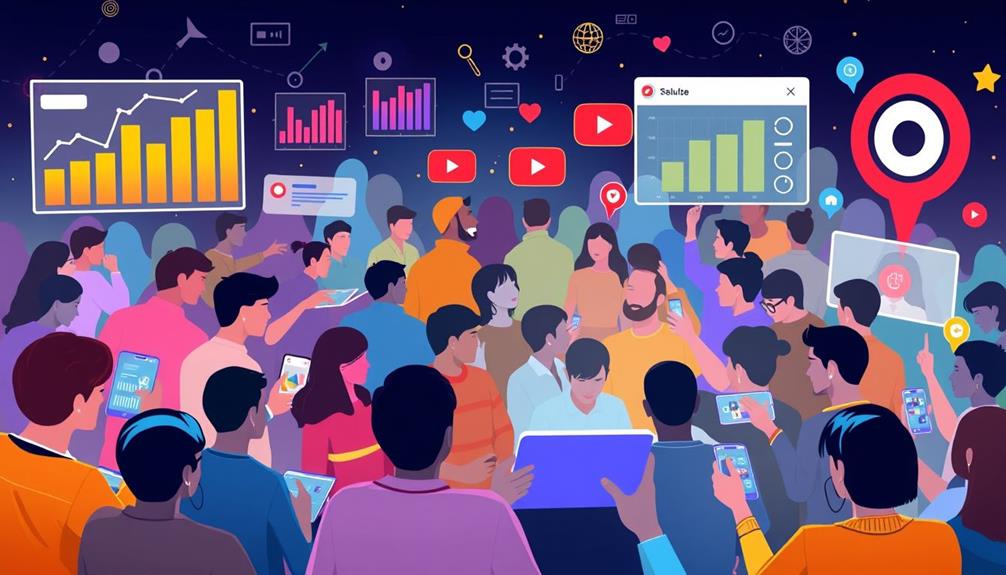
Understanding your audience is the cornerstone of effective video SEO. To truly connect with your target audience, you need to implement solid audience targeting strategies.
Here are three key points to reflect upon:
- Know your demographics: Tailor your content to the interests and preferences of your specific target audience, as building a strong reputation through social proof can foster loyalty among viewers.
- Conduct keyword research: Use tools like Google Trends and VidIQ to find topics your audience actively searches for. This enhances your content's discoverability.
- Engage and gather feedback: Interact with your viewers through comments and polls to gain valuable insights that can guide your content strategy.
Performance Metrics Analysis

When it comes to optimizing your video content, understanding key performance indicators is vital. Metrics such as viewer retention rates and engagement metrics are essential in evaluating how well your videos resonate with the audience.
Additionally, incorporating user engagement metrics can provide deeper insights into viewer preferences and behaviors. By analyzing these factors, you can make informed adjustments that enhance your video's performance and visibility.
Key Performance Indicators
Several key performance indicators (KPIs) can greatly impact your YouTube SEO strategy. Understanding these metrics is essential for enhancing your video's visibility and effectiveness.
Here are three important KPIs to focus on:
- Watch Time: The total minutes viewers spend watching your videos.
- Click-Through Rate (CTR): The percentage of viewers who click on your video after seeing the thumbnail.
- Average View Duration: The average amount of time viewers watch your videos.
Audience retention is critical; higher retention rates indicate quality content, signaling to the YouTube algorithm to boost your rankings in search results.
Engagement metrics, like likes, comments, and shares, also play a significant role in determining your video's visibility on YouTube and Google.
Viewer Retention Rates
Viewer retention rates are a vital aspect of your video's performance on YouTube. These performance metrics measure how much of your video viewers actually watch, and higher retention can lead to better rankings in search results. Aim for an average view duration of over 50%—videos that meet this threshold typically perform markedly better.
To create engaging content, consider incorporating strategies from Healthy Lifestyle Blogs that inspire and provide practical tips for your audience's wellness.
To boost viewer retention rates, focus on creating compelling introductions within the first 10 seconds. Studies suggest that engaging content at the start can increase retention by up to 30%. Additionally, consider incorporating timestamps and video chapters in your descriptions. These features help viewers navigate to sections of interest, enhancing their overall engagement with your content.
Regularly check your viewer retention data in YouTube Analytics. This tool will help you identify drop-off points, allowing you to make data-driven adjustments to your content strategy.
Understanding where viewers lose interest can guide your future videos, improving engagement and retention. By optimizing these aspects, you can effectively maximize your video's potential and improve its visibility on YouTube.
Engagement Metrics Overview
How do you measure the effectiveness of your video content? Understanding engagement metrics is essential for optimizing your video's performance on YouTube. These metrics help you assess viewer interaction and shape your content strategies.
In a world where credit card debt trends are increasingly relevant, it's important to capture attention quickly. Here are three key factors to reflect on:
- Click-through Rate (CTR): A compelling thumbnail and title can greatly boost your CTR, enhancing video visibility.
- Average View Duration: Longer watch times indicate better viewer retention and satisfaction, which positively influences your search rankings.
- Engagement Rates: Encouraging likes, comments, and shares can lead to improved engagement rates, with a 10% increase correlating with better visibility in search results.
Regularly analyzing these metrics through YouTube Analytics allows you to identify trends and make informed adjustments.
The insights gained will help optimize your content strategies, ultimately leading to sustained growth and improved search rankings.
Enhancing Video Discoverability

To boost your video's discoverability, focus on optimizing key elements like titles, descriptions, and tags with relevant keywords. These keywords signal to the YouTube algorithm what your video is about, directly impacting its SEO and visibility in search results.
Additionally, employing techniques like reviving old friendships can inspire creative content ideas that resonate with your audience.
In addition to strategic keywords, consider adding transcripts and captions. This not only makes your content more accessible but also provides search engines with additional text to index, enhancing your video's discoverability.
Creating compelling thumbnails is another critical factor; a visually appealing thumbnail can increase your click-through rates (CTRs) by up to 30%. This means more viewers engaging with your video and higher visibility overall.
Organizing your videos into well-structured playlists improves user experience and encourages binge-watching, which leads to longer watch times. Longer watch times are essential for boosting your search rankings.
Tools for YouTube Optimization
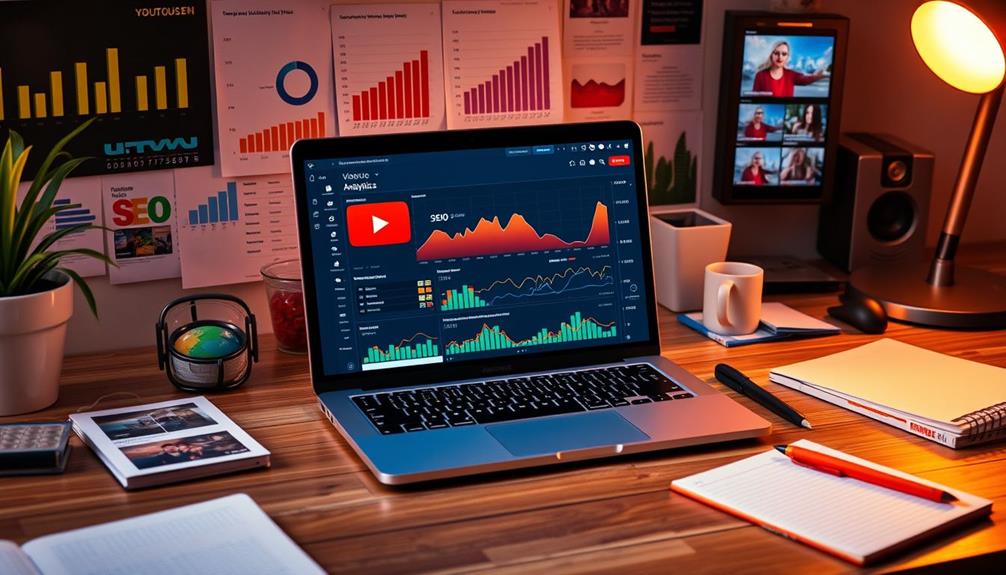
Steering through the complex world of YouTube optimization is made easier with the right tools at your disposal.
These tools not only help you rank your videos but also guarantee your content is optimized for SEO. Here are three essential tools you should consider:
- VidIQ Vision: Helps with keyword research to optimize your video titles, descriptions, and tags.
- Canva: A user-friendly platform for designing eye-catching video thumbnails, vital for increasing click-through rates.
- YouTube Analytics: Provides valuable insights into viewer behavior, allowing you to refine your content strategies based on real data.
Utilizing these tools can enhance your video marketing efforts and improve content quality.
For deeper insights, consider Semrush or Ahrefs for competitor analysis and to identify trending topics.
Additionally, the free YouTube for Business Kit offers templates that help maintain consistent messaging and optimize video SEO effectively.
Best Practices for Engagement
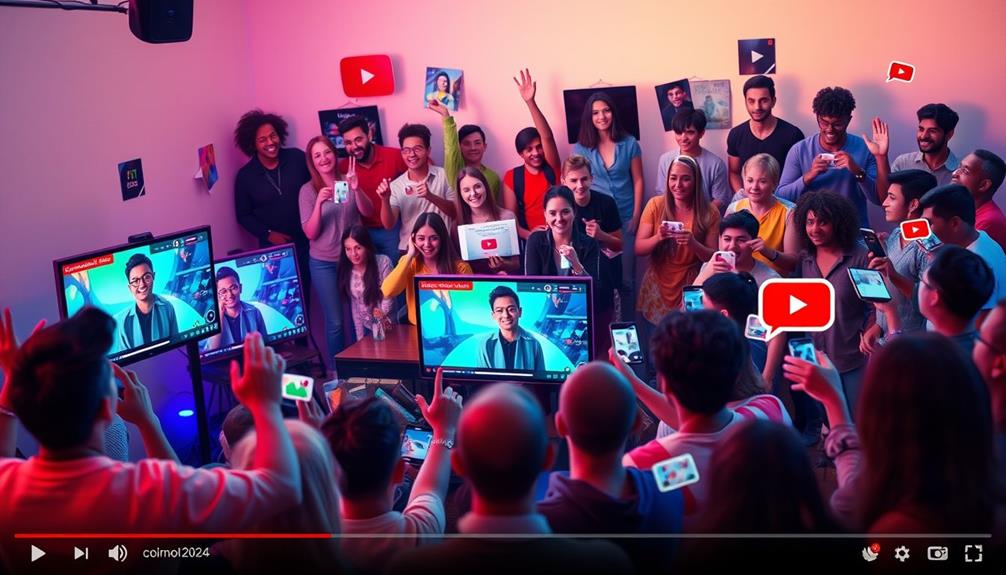
Engagement is essential for your video's success on YouTube, as it directly influences visibility and rankings. To boost viewer interaction, create engaging content that encourages likes, comments, and shares. Incorporating effective call-to-action (CTAs) within your videos can greatly enhance engagement metrics, leading to improved audience retention and interaction.
Focus on crafting compelling content that maintains a longer average view duration, as this plays a critical role in higher rankings. Use interactive elements like YouTube Cards and end screens to keep viewers engaged, guiding them to additional content or encouraging subscriptions. This not only enriches viewer experience but also enhances overall channel interactivity.
Regularly analyzing viewer engagement metrics is important. Look at click-through rates (CTR) and audience retention rates to understand what resonates with your audience. As a content creator, refining your strategies based on this data can lead to improved video performance and increase your search potential.
Conclusion
So, if you're ready to become the next YouTube sensation, remember: it's not just about filming your cat doing backflips, though that's a solid start. Nail your SEO game, sprinkle in some keyword magic, and craft those click-worthy thumbnails. With a bit of audience targeting and performance tracking, you'll be basking in likes and subscribers before you can say "viral." Just don't forget to keep it engaging—your cat's fame depends on it!
Chris, SEO and Keywords Expert & Author: Chris lives and breathes SEO. With a deep understanding of keyword research and strategy, he’s our go-to guru for everything related to search rankings. Chris has a knack for identifying trends and opportunities in the SEO world, making him an invaluable asset to our team and our clients.
Holistic SEO
Green SEO: Optimizing for Sustainability-Conscious Consumers
Maximize your online impact with Green SEO strategies that attract sustainability-conscious consumers—discover how to make your brand stand out today.

To attract sustainability-conscious consumers, you need to embrace green SEO strategies that focus on eco-friendly optimization. Start with energy-efficient web hosting and coding, which can reduce your site's energy consumption considerably. Create high-quality, evergreen content that resonates with eco-conscious values while optimizing site speed for a better user experience. Utilize keyword clustering for relevant topics and guarantee your site is mobile-friendly. Engaging in social media and fostering community ties enhances visibility. By implementing these practices, you can boost brand trust and loyalty. There's much more to explore in making your online presence greener.
Key Takeaways
- Implement green web hosting and efficient coding practices to reduce energy consumption and improve website performance for sustainability-conscious consumers.
- Create high-quality evergreen content focused on eco-friendly topics to attract eco-conscious audiences and enhance organic search rankings.
- Optimize images and utilize responsive design to improve mobile loading times, catering to the increasing number of consumers using mobile devices.
- Incorporate sustainable messaging across digital marketing channels to build brand trust and attract consumers willing to pay more for eco-friendly products.
- Regularly audit site performance and user engagement metrics to align with sustainability goals and enhance the overall user experience.
Understanding Green SEO
Green SEO is all about optimizing your website with eco-friendly practices that resonate with today's environmentally conscious consumers. By adopting sustainable practices, you can notably lower your digital footprint and enhance your brand's appeal.
This entails using eco-friendly SEO practices that prioritize energy-efficient web hosting and coding to reduce your overall carbon footprint. Incorporating renewable energy strategies, like geothermal energy applications, can further position your brand as a leader in sustainability.
To truly grasp Green SEO, you should focus on creating high-quality evergreen content that aligns with sustainability themes. Google's algorithms are increasingly favoring websites that showcase environmental responsibility, so integrating eco-centric keywords into your content can boost your search rankings.
Additionally, consider the impact of your website's speed; a fast-loading site not only improves user experience but also contributes to lower energy consumption. This is a vital aspect of optimizing your website for eco-conscious users.
Benefits of Sustainable Practices

As more consumers prioritize sustainability, adopting eco-friendly practices in your SEO strategy can greatly enhance your brand's appeal. By implementing sustainable SEO practices, you can reduce your website's energy consumption by 20-30%, directly benefiting both your environmental impact and operational costs.
This commitment to sustainability can attract up to 76% of eco-conscious consumers who prefer brands that align with their values, boosting customer loyalty and engagement. In addition, utilizing AI security measures can protect sensitive data while supporting sustainable practices through efficient resource management.
Websites that focus on energy efficiency often experience faster loading speeds, which can improve search rankings by up to 15%. This not only elevates your SEO success but also enhances user experience and retention.
Additionally, integrating green messaging into your content can lead to a 50% increase in organic traffic, especially when targeting environmentally focused keywords.
Moreover, companies showcasing their commitment to sustainability see a remarkable 30% increase in brand trust among consumers. This trust considerably influences purchasing decisions and brand preference.
Implementing Eco-Friendly Strategies

To truly capitalize on the benefits of sustainable practices, you need to implement eco-friendly strategies in your SEO efforts. Start by choosing green web hosting services that utilize renewable energy sources, which can greatly reduce your website's carbon footprint.
Additionally, consider the importance of keyword clustering to enhance your site's relevance and discoverability, aligning your content with sustainable topics that attract eco-conscious consumers.
Next, optimize your website's efficiency by compressing images and minimizing code. This not only enhances loading times but also decreases energy consumption, aligning perfectly with eco-friendly practices.
Embrace sustainable web design principles by adopting minimalistic designs and optimizing multimedia content. These strategies contribute to lower energy usage and greatly improve user experience.
Additionally, focus on creating high-quality evergreen content that remains relevant over time, reducing the need for frequent updates and conserving digital resources.
Addressing Technical Challenges

Technical challenges in Green SEO often arise when you try to balance website performance with energy-efficient practices.
To effectively tackle these challenges, you should focus on several key areas:
1. Choose sustainable web hosting: Opt for eco-friendly hosting services that align with your sustainability goals while guaranteeing compatibility with existing website structures.
Emphasizing a commitment to sustainability can resonate with island getaways that offer unique experiences for eco-conscious travelers.
2. Implement efficient coding: Simplify your code to minimize resource-heavy elements, helping to reduce energy consumption and your website's carbon footprint.
3. Regularly audit your site: Monitor technical limitations to guarantee that your sustainability measures don't negatively impact SEO performance or user experience.
4. Foster collaboration: Encourage teamwork between your technical team and sustainability experts to integrate green practices seamlessly into your website architecture.
Measuring Green SEO Success

Measuring the success of your Green SEO initiatives requires a holistic approach that goes beyond traditional metrics. Instead of focusing solely on organic traffic and rankings, you should also assess environmental impact indicators like your reduced carbon footprint and energy consumption.
Incorporating sustainable practices in your content creation can also enhance your brand's credibility and appeal to sustainability-conscious consumers. Utilize tools like Google Analytics and website performance metrics to evaluate changes in website speed and efficiency, which are essential for your sustainability goals.
Engaging in regular content performance audits can provide insights into how well your eco-friendly messaging resonates with your audience. This helps refine your sustainable content strategies.
Additionally, tracking user engagement metrics—like time on site and bounce rates—can gauge the effectiveness of your sustainable design practices, ensuring they enhance user experience.
Aligning your key performance indicators (KPIs) with broader sustainability goals, such as promoting renewable energy topics or local eco-initiatives, will help you measure how well your Green SEO practices contribute to your overall brand sustainability commitments.
Enhancing User Experience

To enhance user experience, you need to focus on mobile optimization techniques that guarantee your site loads quickly and looks great on any device.
Confirming that your site has a responsive design is essential for catering to a wider audience, especially as more consumers seek services such as home cleaning options.
Intuitive navigation design makes it easier for visitors to find what they need, boosting engagement and conversions.
Plus, incorporating multimedia content efficiently can create a more dynamic browsing experience while reducing data transfer.
Mobile Optimization Techniques
In today's digital landscape, optimizing your website for mobile users isn't just a luxury; it's a necessity. With mobile devices accounting for over 50% of global web traffic, you need to make sure your site loads quickly and efficiently to enhance user experience while minimizing energy consumption.
Implementing techniques that prioritize user engagement, such as leveraging social media platforms, can further attract sustainability-conscious consumers. Here are some key mobile optimization techniques you should implement:
- Responsive Design: This makes certain your website adapts seamlessly to different screen sizes, improving usability and reducing data transfer.
- Lazy Loading: By only loading images and multimedia when they appear in the viewport, you can greatly decrease initial loading times, boosting performance and user engagement.
- Image Compression: Optimize images and code to make loading times faster, which not only enhances user experience but also reduces the carbon footprint associated with data transfer.
- Mobile-First Indexing: Focus on this strategy as search engines prioritize mobile versions of websites, improving visibility among sustainability-conscious consumers.
Intuitive Navigation Design
As mobile optimization sets the foundation for a great user experience, intuitive navigation design takes it a step further by guaranteeing users can effortlessly explore your website. By prioritizing clear labeling and a logical hierarchy, you help users easily find eco-friendly products and resources, boosting their overall satisfaction.
Successful SQA engineers also emphasize thorough testing processes, which is vital for identifying any usability issues that may arise. Implementing breadcrumb navigation can also enhance usability, allowing users to understand their location within your site and reducing the clicks needed to access sustainable content.
With over 50% of web traffic coming from mobile devices, it's important to create a design that guarantees seamless navigation on smaller screens. Utilizing a responsive design approach ensures that your navigation elements adapt well across devices, maintaining consistency and encouraging deeper exploration of your sustainable offerings.
Don't forget to incorporate effective search functionality with eco-centric filters. This allows sustainability-minded users to quickly access green products or information, catering to their specific needs efficiently.
Multimedia Content Efficiency
Effective multimedia content can noticeably enhance user experience while also promoting sustainability. By optimizing your images and videos, you can reduce file sizes through compression techniques, leading to faster loading times and decreased energy consumption.
Additionally, reflect on how candle maintenance and care can parallel the principles of digital efficiency; just as regular upkeep prolongs the life of candles, consistent optimization can extend the lifespan of your website's multimedia elements.
Here are four key strategies to reflect on:
- Implement lazy loading: This guarantees that only the necessary files for the initial view load, greatly enhancing site performance and reducing your digital carbon footprint.
- Utilize efficient video formats: Using codecs like H.264 or VP9 minimizes bandwidth requirements, improving user experience while using less energy.
- Design for dark mode: Darker backgrounds save energy on OLED screens, making your website more environmentally friendly and accessible.
- Regularly audit multimedia content: Identify optimization opportunities to boost site performance metrics, positively impacting search engine rankings and user engagement.
Incorporating these strategies not only creates an engaging multimedia experience but also contributes to a more sustainable web.
Aligning Brand Values

Aligning your brand values with sustainability isn't just a trend; it's a powerful way to build trust with consumers. As you commence your sustainability journey, consider that 66% of global consumers are willing to pay more for sustainable brands. A commitment to ethical practices not only enhances your reputation but also reflects a deep understanding of the impact of narcissistic abuse on relationships, which resonates with consumers seeking authenticity.
By clearly developing a brand narrative that emphasizes your environmental responsibility, you can notably enhance brand loyalty, especially among millennials, with 81% more likely to support eco-friendly businesses.
Integrating green practices consistently across all your digital marketing efforts reinforces your commitment to sustainability. This approach not only attracts environmentally conscious consumers but also positions your brand favorably in a market projected to exceed $150 billion.
Collaborating with eco-friendly organizations can further amplify your messaging, as consumers are 4.2 times more likely to trust brands that support social causes.
Don't overlook the power of sustainable SEO strategies. Not only do they improve search rankings, but they also align your brand with the growing demand for transparency and authenticity—73% of consumers prioritize these traits when making purchasing decisions.
Fundamentally, aligning brand values with sustainability is essential for fostering consumer trust and loyalty in today's market.
Multi-Channel Marketing Integration

Integrating green messaging across diverse marketing channels is essential for resonating with sustainability-conscious consumers. A cohesive approach enhances your brand image while showcasing your commitment to eco-friendly practices.
Here are four effective strategies for multi-channel marketing integration:
- Utilize digital platforms: Leverage social media, email, and blogs to share eco-friendly content, increasing visibility and attracting a growing demographic of eco-conscious shoppers.
- Engage in content sharing: Collaborate with eco-focused organizations for cross-promotion. This amplifies your sustainability message and helps you reach a wider audience.
- Incorporate local SEO: Target local communities through tailored marketing strategies. This strengthens brand loyalty among environmentally aware consumers and fosters community involvement.
- Analyze performance metrics: Regularly assess your multi-channel marketing efforts. Identifying effective strategies will enhance the reach and impact of your sustainability messaging across all platforms.
Future Trends in Green SEO

As businesses embrace the importance of sustainability, Green SEO is evolving to meet the demands of eco-conscious consumers. You'll find that a growing number of consumers are willing to pay more for eco-friendly products, pushing you to adopt innovative SEO strategies that highlight your commitment to sustainability.
With advancements in artificial intelligence and machine learning, you can expect more accurate keyword suggestions focused on the sustainable web, enhancing your online presence.
The shift towards mobile and voice search means you need to optimize for these trends while maintaining your eco-friendly practices. As 87% of consumers prefer brands that prioritize environmental responsibility, integrating renewable energy sources into your digital operations can greatly reduce your carbon footprint.
Future Green SEO strategies will increasingly focus on local SEO and community engagement. As more consumers seek to support local businesses with sustainable practices, you'll notice a 30% increase in local search queries related to sustainability.
Opportunities for Sustainable Growth

You can tap into opportunities for sustainable growth by forming eco-friendly partnerships that align with your brand values.
Innovative marketing strategies can help you reach eco-conscious consumers enthusiastic to support sustainable initiatives.
Eco-Friendly Partnerships
Forming eco-friendly partnerships can greatly elevate your brand's sustainability efforts while driving growth. By collaborating with like-minded organizations, you not only enhance your credibility but also connect with sustainability-conscious consumers.
Here are four key benefits of establishing these partnerships:
- Boosted Visibility: Collaborating with eco-friendly brands increases your visibility, as 77% of consumers prefer brands supporting sustainability initiatives.
- Amplified Reach: Partnering with sustainability influencers can considerably enhance your reach, yielding up to 11 times higher ROI through influencer marketing.
- Community Engagement: Joining forces with local environmental organizations fosters goodwill, with 63% of consumers more likely to support businesses contributing to local sustainability efforts.
- Consumer Trust: Participating in green certifications through partnerships can bolster consumer trust, as 66% of global consumers are willing to pay more for sustainable brands.
Innovative Marketing Strategies
In the domain of sustainable growth, innovative marketing strategies play a pivotal role in connecting with eco-conscious consumers. By incorporating storytelling into your online content, you can effectively highlight your brand's sustainability journey, fostering trust and engagement.
With 66% of consumers willing to pay more for sustainable brands, this approach can considerably enhance your marketing strategy.
Utilizing social media platforms to share eco-friendly content can boost your brand visibility, as 70% of consumers are more likely to purchase from brands that actively promote their sustainability efforts.
Collaborating with eco-conscious influencers can further enhance your credibility and reach, yielding up to 11 times higher ROI compared to traditional marketing.
Additionally, targeted email marketing campaigns featuring sustainable products can increase your open rates by 20% and click-through rates by 25% among environmentally conscious consumers.
Don't forget to leverage data analytics to understand consumer preferences for sustainability, as 72% of consumers expect brands to take action on environmental issues.
Conclusion
You've learned how to optimize for sustainability-conscious consumers, but let's be honest—who wouldn't want to save the planet while boosting their brand? By embracing green SEO, you're not just joining a trend; you're becoming a part of a movement that actually matters. So, while your competitors scramble to catch up, you'll be leading the charge with eco-friendly strategies. Isn't it ironic? The more you care, the more your business thrives. Now, isn't that a win-win?
Chris, SEO and Keywords Expert & Author: Chris lives and breathes SEO. With a deep understanding of keyword research and strategy, he’s our go-to guru for everything related to search rankings. Chris has a knack for identifying trends and opportunities in the SEO world, making him an invaluable asset to our team and our clients.
Holistic SEO
Preparing for Web 3.0: The Impact on Search and Marketing
Prepare for Web 3.0’s transformative impact on search and marketing, as understanding decentralized strategies could redefine your business’s future success. Discover the key insights now!

Preparing for Web 3.0 means you'll need to rethink your search and marketing strategies. Emphasize community engagement to build trust and loyalty, as this will set you apart in a competitive landscape. Focus on SEO optimization using relevant keywords and semantic search tactics. Incorporating decentralized applications and understanding blockchain technology will also enhance data security and user control. Don't forget to tap into NFTs to attract tech-savvy consumers. By adapting to these trends, you'll position yourself for success as the digital marketing world evolves. There's much more to explore about these strategies and their implications.
Key Takeaways
- Web 3.0 emphasizes the semantic web, improving search accuracy through AI-driven content understanding and user intent analysis.
- Brands must adapt SEO strategies to focus on semantic search tactics, ensuring relevance to evolving consumer queries.
- Community engagement becomes vital, allowing brands to gather insights and foster loyalty through direct consumer interactions.
- The integration of blockchain technology enhances data security, requiring brands to prioritize transparency in user data collection and privacy.
- Utilizing NFTs and dApps in marketing strategies can attract tech-savvy consumers and drive engagement through unique digital experiences.
Understanding Web 3.0 Marketing
Web 3.0 marketing represents a revolutionary shift in how brands connect with consumers. By leveraging advanced technologies like AI and the semantic web, you can create personalized user experiences that meet the rising consumer demand and preferences. This shift is essential, especially since 63% of digital marketing leaders struggle to deliver tailored content.
As AI advancements raise significant privacy concerns, it's imperative to incorporate ethical considerations in AI deployment to build consumer trust.
Community engagement plays an important role in Web 3.0 marketing. It allows you to gather valuable insights and foster loyalty through direct interactions with your audience, enhancing brand trust. Additionally, the integration of blockchain technology boosts data security and transparency, giving users control over their personal information and influencing target marketing strategies.
NFTs in marketing have emerged as an exciting avenue to attract tech-savvy consumers. Brands like Taco Bell and Coca-Cola have successfully utilized unique digital assets to enhance visibility.
Furthermore, the rise of the metaverse opens doors for immersive marketing experiences, with companies like Nike and Samsung engaging consumers through virtual environments.
Embracing these elements will position you at the forefront of Web 3.0 marketing, enabling you to create meaningful connections and drive brand loyalty in an evolving digital landscape.
Key Strategies for Web 3.0
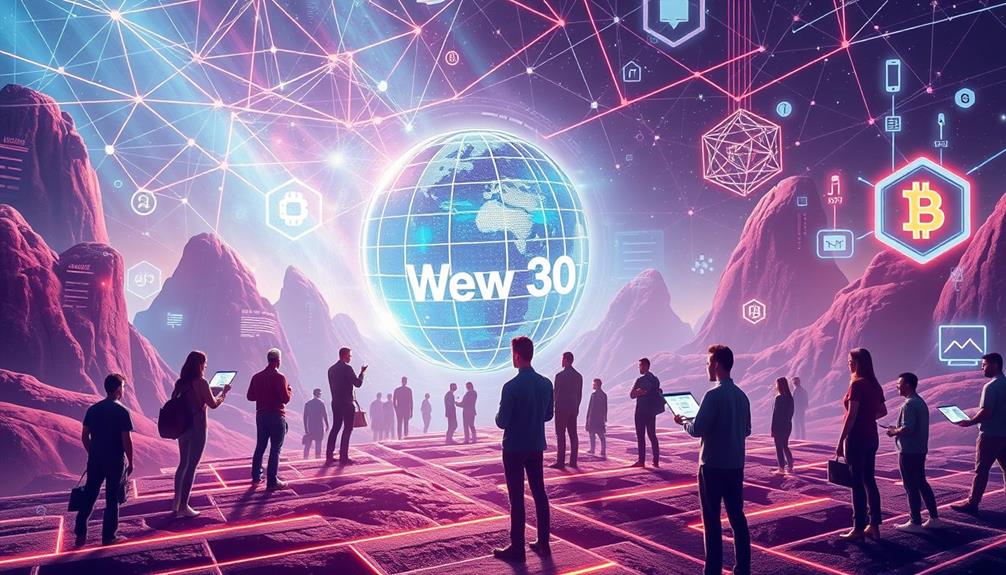
Success in the evolving landscape of digital marketing requires you to adopt effective strategies tailored to Web 3.0. First, prioritize community engagement. By actively involving your audience, you'll gather valuable insights and feedback that enhance your data analytics capabilities, fostering brand loyalty.
Engaging with audiences through comments and social media can build community and increase visibility, especially when leveraging keyword clustering strategies.
Next, leverage decentralized applications (dApps) to guarantee secure and transparent customer interactions. This builds trust and reinforces your brand's credibility.
SEO optimization remains essential in this new digital landscape. Focus on relevant keywords and semantic search tactics to maintain visibility, especially as AI technologies reshape search behavior.
Additionally, consider incorporating NFTs into your marketing strategies. Unique digital assets can attract tech-savvy consumers, as seen with Taco Bell's successful digital taco artwork campaign.
Real-World Web 3.0 Examples

The rise of Web 3.0 has sparked innovative marketing campaigns that blend digital assets with traditional engagement methods.
Take Macy's NFT Parade, for example. They showcased a virtual Thanksgiving Day parade where NFT-based balloons were auctioned, seamlessly integrating digital assets into event marketing. This innovative approach mirrors the potential of diversifying investment portfolios through alternative assets, similar to how the benefits of converting 401k to Gold IRA can enhance financial resilience.
Taco Bell also made waves with its NFT campaign, selling digital taco artwork for just $1 and selling out in under 30 minutes—an impressive feat that highlights the demand for branded digital collectibles.
Samsung's launch of a Discord community exemplifies how brands can leverage decentralized platforms for direct consumer engagement.
Meanwhile, Nike ventured into the metaverse by creating virtual sneakers for avatars, allowing users to buy and wear digital products in immersive environments. This move not only enhances brand presence but also taps into the growing interest in virtual fashion.
Coca-Cola took a unique approach by releasing limited edition NFTs that blend art and brand identity, reinforcing brand loyalty and consumer engagement.
These real-world examples showcase how companies are effectively using digital marketing strategies to adapt to Web 3.0, proving that the future of marketing is indeed digital and decentralized.
Challenges in Digital Marketing

Maneuvering the complexities of digital marketing poses significant challenges for brands looking to engage consumers effectively. One major hurdle is the shift away from third-party cookies, with 63% of digital marketing leaders struggling to provide a personalized user experience. This creates a pressing need for innovative marketing solutions that can adapt to new data collection methods while respecting data privacy and security regulations like GDPR.
Additionally, as businesses explore risk management tactics to protect their investments, they must also consider how these strategies can enhance their marketing efforts.
Furthermore, the rapid evolution of web technology means you must stay on top of changing consumer expectations and emerging trends. Increased competition in the digital landscape requires continuous skill development and the constant adaptation of marketing strategies. If you fail to keep pace, your brand risks being overshadowed.
As global spending on digital marketing is projected to rise from $522.5 billion in 2023 to $836 billion by 2026, the stakes are higher than ever. You'll need to embrace new approaches while addressing the challenges in digital marketing to carve out a competitive edge.
Balancing innovation with transparency in your marketing efforts will be essential to meet the demands of today's consumers and thrive in this dynamic environment.
Preparing for the Future

Steering through the challenges in digital marketing today sets the stage for preparing for the future with Web 3.0. To thrive, you need to grasp blockchain technology, as it guarantees data security and transparency while enabling decentralized applications that will reshape your marketing strategies.
Embracing continuous learning—like courses on AI and machine learning—will also be vital, especially since 84% of digital marketers find that these technologies enhance real-time personalization efforts. Additionally, leveraging effective email marketing strategies can greatly boost your outreach and engagement in this new landscape.
As you adapt, keep in mind the stricter data privacy regulations requiring explicit user consent for data collection. In this evolving landscape, consumer trust is paramount. Focus on community-driven marketing, engaging directly with your audience to build loyalty and gain insights into their preferences.
With digital marketing spending projected to soar from $522.5 billion in 2023 to $836 billion by 2026, leveraging Web 3.0 technologies isn't just smart; it's critical to remain competitive and relevant. By preparing now, you'll position yourself to navigate the future of marketing effectively while meeting the demands of an increasingly savvy consumer base.
Conclusion
As you dive headfirst into the vibrant world of Web 3.0, imagine a marketing universe where your brand shines like a thousand suns, dazzling your audience with personalized experiences that seem almost magical. You'll harness the power of decentralized networks, crafting strategies that feel like they were plucked from a sci-fi novel. Embrace the challenges ahead, and watch your brand transform into an unstoppable force, paving the way for a future that's as thrilling as a rollercoaster ride through the cosmos!
Chris, SEO and Keywords Expert & Author: Chris lives and breathes SEO. With a deep understanding of keyword research and strategy, he’s our go-to guru for everything related to search rankings. Chris has a knack for identifying trends and opportunities in the SEO world, making him an invaluable asset to our team and our clients.
Holistic SEO
SEO for Virtual and Augmented Reality Experiences
Harness the power of SEO for virtual and augmented reality experiences to enhance visibility and user engagement—discover the secrets to effective optimization.

To maximize SEO for virtual and augmented reality experiences, you need to focus on boosting visibility and user engagement. Start by optimizing keywords in your page titles, meta descriptions, and headings. Address unique challenges like large file sizes and mobile compatibility to improve loading times and accessibility. Incorporate interactive elements to enhance user retention, and use analytics to track engagement metrics. Don't forget about the importance of a mobile-friendly design, as most users access AR content on their smartphones. There's much more to explore about optimizing your VR and AR content for search engines effectively.
Key Takeaways
- Optimize page titles, meta descriptions, and headings with relevant keywords to improve visibility of VR and AR content.
- Implement mobile-friendly designs to enhance user experience and accessibility for smartphone users accessing immersive experiences.
- Utilize compression techniques and efficient file formats to reduce large file sizes, improving loading times and performance.
- Monitor user engagement metrics like bounce rates and time on site to refine content and boost SEO rankings.
- Regularly assess and update SEO strategies to align with search engine algorithm changes and improve discoverability.
Understanding VR and AR
When you explore the world of Virtual Reality (VR) and Augmented Reality (AR), it's vital to understand their distinct characteristics. VR offers fully immersive experiences, often requiring specialized headsets to transport you to simulated environments. In contrast, AR overlays digital content onto your real world, usually accessed through smartphones or AR glasses. The integration of technologies like geothermal energy can further enhance these experiences by providing sustainable power solutions for VR and AR devices.
The applications of VR are primarily found in gaming and exploration, providing thrilling adventures and unique experiences. On the other hand, AR enhances real-life situations, making it invaluable in areas like navigation, virtual try-ons, and interactive content marketing.
Both technologies push user engagement to new heights, creating opportunities for businesses to connect with customers in innovative ways.
Major tech companies are heavily investing in AR, anticipating a global market projection of around $209 billion by the end of 2022. This investment signals AR's potential to revolutionize digital marketing strategies and boost local business visibility through engaging, location-based experiences.
As you dive deeper into VR and AR, you'll see how they can transform industries, with VR advancing gaming and healthcare, while AR reshapes marketing and user interactions. Understanding these differences is important for anyone looking to leverage these technologies effectively.
Importance of SEO for VR/AR

SEO is essential for your VR and AR content because it boosts visibility and helps users find your immersive experiences.
As AI advancements raise significant privacy concerns, ensuring that your content complies with data protection regulations is imperative.
You'll face unique challenges, like large file sizes and limited indexing, which means you'll need to adopt tailored strategies.
Additionally, focusing on user engagement metrics can enhance your rankings, so optimizing your content is fundamental for success.
Ethical considerations are crucial in educational data mining.
Enhanced Visibility Strategies
To thrive in the competitive landscape of virtual and augmented reality, enhancing your visibility through effective SEO strategies is essential. SEO plays a significant role in making your VR and AR content easily discoverable. By optimizing your content with relevant keywords, you can improve your search engine rankings, leading to increased user engagement and site traffic.
Additionally, leveraging social proof through testimonials and user feedback can further enhance your content's credibility, attracting more users to your immersive experiences.
Start by optimizing page titles, meta descriptions, and headings to reflect the unique aspects of your immersive experiences. This will capture the attention of both search engines and users.
Additionally, implementing a mobile-friendly design is critical, as most VR and AR experiences are accessed on smartphones and tablets, which search engines prioritize.
Unique Content Challenges
Steering through the unique content challenges of VR and AR requires a tailored approach to SEO that goes beyond traditional techniques.
You'll quickly find that the large file sizes and complexity of immersive experiences often thwart standard SEO strategies. Instead, focusing on creating engaging content that resonates with users is key. By integrating AR technology, you can craft unique, shareable experiences that enhance storytelling and brand messaging—essential factors in boosting your search engine rankings.
Furthermore, understanding the importance of risk management in your digital strategy can help mitigate potential pitfalls associated with these technologies.
To improve user experiences, prioritize VR/AR-friendly website designs that guarantee accessibility and ease of navigation. This not only keeps your audience engaged but also helps lower bounce rates, which can positively influence your SEO performance.
Remember, continuous adaptation and monitoring of your SEO strategies are crucial as advancements in VR and AR technologies emerge. By staying updated, you'll guarantee your content remains visible and relevant in search results.
Ultimately, embracing these unique content challenges will empower you to deliver immersive experiences that captivate your audience and elevate your presence in search engines.
Don't underestimate the power of tailored SEO efforts in this evolving landscape.
User Engagement Metrics
User engagement metrics play an essential role in determining the success of your VR and AR experiences. These metrics, such as time on site and bounce rates, help you gauge how well users are interacting with your content. Higher user interaction usually leads to improved search engine rankings, making it vital to focus on engagement.
| User Engagement Metric | Importance |
|---|---|
| Time on Site | Longer visits boost rankings |
| Bounce Rate | Lower rates indicate better UX |
| Interactive Content | Keeps users engaged longer |
| Audience Expectations | Meeting these enhances satisfaction |
Engaging VR and AR experiences can greatly increase site visits, with studies showing that interactive content keeps users on a page up to three times longer than traditional content. As search engines evolve, they'll prioritize websites utilizing these technologies effectively. By continuously tracking user engagement metrics, you can refine your VR and AR strategies to meet audience expectations and enhance overall user satisfaction. Remember, the more engaged your users are, the better your search engine rankings will be, leading to greater visibility and success.
Unique SEO Challenges
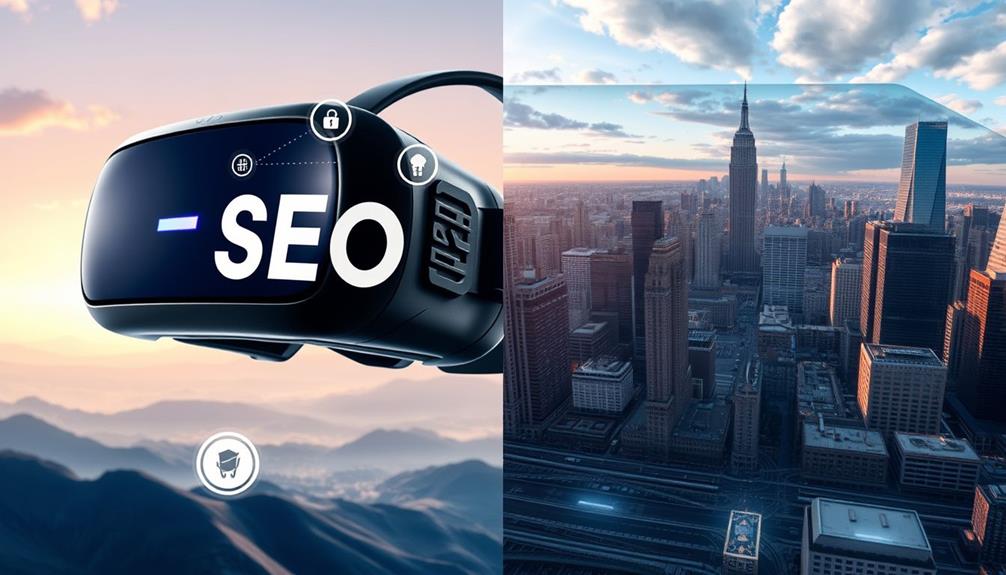
When optimizing for VR and AR, you'll face unique SEO challenges that traditional strategies can't easily address.
Large file sizes can slow down loading times, while measuring user engagement in these immersive environments isn't straightforward.
Additionally, just as air purifiers improve indoor air quality, ensuring your content is mobile-friendly is essential, as many users access AR experiences through their smartphones.
File Size Optimization
Optimizing file sizes is essential for enhancing the performance and accessibility of VR and AR content. Large file sizes can lead to slow loading times, which negatively impact user experience and engagement metrics—key factors for improving SEO rankings. To tackle this challenge, you should implement effective file size optimization strategies without sacrificing quality.
Additionally, converting traditional assets to more stable forms such as gold can provide a safeguard against market fluctuations, similar to how diversification of retirement portfolio reduces risk exposure in financial planning.
Using compression techniques and efficient file formats like GLTF for 3D models can considerably reduce file sizes while maintaining visual fidelity. Given that the average VR video file can range from 1GB to over 10GB, it's essential to adopt these strategies to guarantee quick access and smooth playback for users.
Additionally, consider implementing lazy loading techniques, which allow VR/AR content to load only when needed. This approach improves page speed and reduces initial load times, both of which are critical for SEO.
Regularly evaluating and updating file sizes as part of your ongoing SEO strategy can help you adapt to evolving technology and user expectations. By focusing on file size optimization, you'll enhance the overall user experience and boost your VR and AR content's search visibility.
User Engagement Measurement
Measuring user engagement in VR and AR experiences often presents unique challenges due to their immersive nature. Traditional metrics like bounce rate don't apply here. Instead, you'll focus on metrics that truly reflect how users interact with your content. Key indicators include time spent in the experience, interaction rates with virtual objects, and completion rates of tasks, which are critical for evaluating user engagement.
To help you visualize these metrics, here's a simple breakdown:
| Metric Type | Description | Importance |
|---|---|---|
| Interaction Rates | Frequency of user interactions with virtual objects | Indicates user interest |
| Completion Rates | Percentage of users finishing tasks | Measures engagement level |
| Qualitative Data | Feedback and surveys post-experience | Provides insights for improvement |
Utilizing specialized analytics tools designed for immersive experiences can help you track user behavior accurately. Additionally, collecting qualitative data through user feedback can reveal user satisfaction and highlight areas for improvement in your AR experiences. By focusing on these unique metrics, you'll gain a clearer picture of user engagement in your immersive environments.
Mobile-Friendliness Importance
Ensuring mobile-friendliness is essential for effectively reaching users in the world of VR and AR. A considerable number of users access immersive experiences through mobile devices, making responsive design imperative for ideal interaction.
Remarkably, homes without security systems are 300% more likely to be burglarized, highlighting the importance of user trust and safety in any technology, including home security systems. Search engines prioritize mobile-friendly websites, so your VR and AR content must be visually appealing and easily navigable on these platforms to enhance visibility.
Fast loading times and smooth performance on mobile devices are critical. If your AR applications lag or take too long to load, you risk losing user engagement and satisfaction.
Mobile-friendliness greatly impacts user experience metrics, such as bounce rates and time on site, which are essential factors search engines consider when ranking your content.
Effective SEO Strategies

As the landscape of virtual and augmented reality continues to evolve, implementing effective SEO strategies becomes essential for reaching your audience. Start by prioritizing mobile-friendliness and user experience, since most users engage with VR and AR content on their mobile devices. Utilize keyword research tools like Google Keyword Planner to identify relevant terms that boost visibility and engagement.
Here's a quick overview of effective SEO strategies for your VR and AR content:
| Strategy | Description |
|---|---|
| Keyword Optimization | Optimize page titles, meta descriptions, and headings with targeted keywords. |
| Multimedia Integration | Incorporate engaging and interactive multimedia elements, ensuring they load quickly for better user engagement. |
| Regular Assessments | Regularly assess and adapt your SEO strategies to align with search engine algorithm changes. |
Technical Considerations

When developing virtual and augmented reality content, technical considerations play a vital role in delivering a seamless user experience. You need to focus on optimizing various aspects to guarantee that your VR content and AR applications function flawlessly across devices.
For instance, understanding the importance of cybersecurity can also be essential in protecting user data during immersive experiences.
Here are some key points to keep in mind:
- Optimize file sizes to improve loading times and reduce latency.
- Implement efficient coding techniques to enhance performance by minimizing heavy scripts.
- Guarantee compatibility with different browsers and platforms to maximize accessibility.
- Regularly assess and update your technical infrastructure to align with SEO best practices.
- Continuously monitor user experience metrics like loading times and responsiveness for timely improvements.
Enhancing User Experience

A great user experience in virtual and augmented reality is essential for keeping your audience engaged and satisfied. To achieve this, focus on enhancing user experience by optimizing loading times. Faster content delivery reduces user frustration and minimizes dropout rates during immersive experiences.
Implementing keyword clustering can also help organize your content, making it easier for users to navigate through various VR/AR experiences.
Implementing responsive design is vital, ensuring seamless functionality across various devices like smartphones, tablets, and VR headsets. This adaptability allows users to enjoy your content without hiccups, regardless of their chosen platform.
Incorporating interactive elements, such as 360-degree views and virtual try-ons, can greatly boost user engagement, leading to longer session durations and improved retention rates.
Regularly updating and maintaining your VR/AR content also plays a key role in sustaining user interest and ensuring compatibility with evolving technologies and browser standards.
Utilizing analytics tools to track user interactions and behaviors within your VR/AR experiences provides valuable insights for refining your approach. By analyzing this data, you can enhance content effectiveness and continuously improve user experience, ensuring that your audience remains captivated and enthusiastic to return for more.
Tracking Performance Metrics

Measuring performance metrics is imperative for understanding how well your virtual and augmented reality experiences resonate with users. By tracking user engagement, you can gain insights into what keeps your audience captivated and what doesn't. This information is essential for refining your content and enhancing user satisfaction, similar to how healthy lifestyle blogs provide inspiration and practical tips for wellness.
Consider focusing on the following key performance metrics:
- Time on Site: Indicates how long users engage with your VR and AR experiences.
- Bounce Rate: Shows the percentage of users who leave quickly, highlighting potential content issues.
- Conversion Rates: Measures how effectively your experiences lead to sales or desired actions.
- Customer Feedback: Collect insights through surveys to understand user expectations and satisfaction.
- Social Media Metrics: Analyze likes, shares, and comments to gauge brand engagement and impact.
Continuous optimization is critical. By regularly tracking these performance metrics, you can identify successful content and areas needing improvement.
This proactive approach guarantees that your VR and AR experiences remain relevant and engaging, ultimately driving better conversion rates and fostering stronger audience connections.
Future Trends in VR/AR

The future of VR and AR is brimming with exciting possibilities that promise to reshape how we interact with digital content. With the global AR market projected to reach around $340 billion by 2028, industries are increasingly integrating these technologies into their marketing strategies.
You'll notice that advancements in AI will enhance personalized experiences in Virtual Reality (VR) and Augmented Reality (AR), allowing content to adapt to your preferences and behaviors.
As voice search becomes more prevalent, optimizing your SEO strategy for VR and AR content will be vital. More users engage with immersive experiences through voice-activated commands, making it essential to incorporate voice search optimization into your approach.
Additionally, the rise of 5G technology will facilitate smoother experiences, reducing latency and enabling real-time interactivity in virtual environments.
Social media platforms adopting AR features will also play a significant role in customer engagement. Brands that leverage these tools in their marketing strategies will likely see increased visibility in search rankings, particularly in Google Search.
Integrating AR in Marketing

Incorporating augmented reality (AR) into marketing strategies can dramatically boost user engagement and drive sales. By creating immersive experiences, you'll not only enhance brand awareness but also encourage potential customers to interact with your products in a meaningful way.
AR can improve purchasing decisions through features like virtual try-ons, leading to higher satisfaction and lower return rates.
Here are some key benefits of integrating AR in your marketing:
- Enhanced customer engagement: AR experiences keep users on your site longer, reducing bounce rates.
- Interactive product demonstrations: Allow customers to see products in action, improving their understanding.
- Social media interaction: Create shareable moments that can go viral, increasing brand visibility.
- Realistic visualizations: Help customers envision products in their own spaces, like IKEA's furniture app.
- Competitive edge in digital marketing: The growing AR market shows that adopting these solutions is essential for staying relevant.
Conclusion
In the ever-evolving landscape of VR and AR, mastering SEO isn't just smart—it's essential. As you harness the power of these immersive technologies, remember that optimizing your experiences can elevate your presence in a crowded digital space. By embracing the unique challenges and strategies discussed, you're not just keeping up; you're leading the way into a future where reality blends seamlessly with the virtual. So, why not plunge into and transform your approach today? The future awaits!
Chris, SEO and Keywords Expert & Author: Chris lives and breathes SEO. With a deep understanding of keyword research and strategy, he’s our go-to guru for everything related to search rankings. Chris has a knack for identifying trends and opportunities in the SEO world, making him an invaluable asset to our team and our clients.
-

 Holistic SEO3 months ago
Holistic SEO3 months agoHolistic Local SEO Tactics for Small Businesses
-

 Holistic SEO2 months ago
Holistic SEO2 months agoHow to Establish Dominance in SEO through Topical Authority
-

 Holistic SEO3 months ago
Holistic SEO3 months agoKeyword Research (SEO) for Tattoo Artists
-

 Learning Center3 months ago
Learning Center3 months ago52 Niches with Good Crossover Potential Explored
-

 Learning Center2 months ago
Learning Center2 months agoThe Future of SEO: Leveraging the Google Search Generative Experience
-

 Holistic SEO3 months ago
Holistic SEO3 months agoHolistic SEO Food Blogger
-

 Keyword Research2 months ago
Keyword Research2 months agoMastering SEO: How to Analyze Keyword Results and Find Easy Keywords
-

 Keyword Research3 months ago
Keyword Research3 months agoHow to Keyword Search in Excel





















